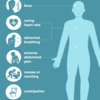Gastrointestinal Flashcards
What is the blood supply to these regions?
Foregut
Midgut
Hindgut
- Foregut - Coeliac Trunk
- Midgut - Superior mesenteric artery
- Hindgut - Inferior mesenteric artery
WHAT IS HELIOCBACTER PYLORI?
Gram negative, curved motile rod, microaerophilic.
What is heliocbacter pylori’s key biochemical feature?
Urease positivity-used in testing.
How is heliocbacter pylori spread?
Oro-fecal or oral-oral.
What is the pathogenesis of heliocbacter pylori?
Adapted to living in gastric mucus Colonises over gastric but not intestinal epithelium.
Induces inflammation
Stimulates increased gastrin
What are some disease associations with heliocbacter pylori?
Ulcers.
In the absence of NSAIDS or Zollinger-Ellison syndrome.
Gastric cancer.
Gastric lymphoma.
Oesophageal disease.
Barrett’s oesophagus.
Others.
What are the usual symptoms of heliocbacter pylori?
- Acquisition usually asymptomatic but may cause nausea and epigastric pain.
- Chronic diffuse superficial gastritis
- Followed by a period of achlorrydria.

What investigations can you do for HP?
- Serology
- Stool antigen
- Urea breath test
- Endoscopy with urease test
- Histology ± culture

What is the treatment for H.pylori?
- Eradication may be achieved with a 7-day course of
- a proton pump inhibitor + amoxicillin + (clarithromycin OR metronidazole)
- if penicillin-allergic: a proton pump inhibitor + metronidazole + clarithromycin
WHAT IS PERITONITIS?
Inflammation of peritoneum.
What are the causes of peritonitis?
What is the most common bacteria?
- Perforation of GI tract i.e. trauma
- E. coli
What are the symptoms of peritonitis?
- Pain
- Rebound tenderness
- Guarding reflex
- Fever
- Increase in WBC
- Shoulder tip pain in sepsis

What are the investigations of peritonitis?
What are the investigations for SBP?
Erect CXR - air under diaphragm.
USS/CT
Neutrophil count >250 cells/microlitre

How can you treat peritonitis?
What is the prophylaxis for SBP?
- IV fluids
-
Antibitoics
- Metronidazole for anaerobes and cephalexin for aerobes
- Electrolytes
- Surgery laparotomy
Prophylaxis - ciprofloxacin

Who should prophylaxis be given to after peritonitis?
What is the prophylaxis?
- Patients who have had an episode of SBP
- Patients with fluid protein <15 g/l and either Child-Pugh score of at least 9 or hepatorenal syndrome
- NICE recommend: ‘Offer prophylactic oral ciprofloxacin or norfloxacin for people with cirrhosis and ascites with an ascitic protein of 15 g/litre or less until the ascites has resolved’
WHAT IS THE DEFINITION OF INTESTINAL OBSTRUCTION?
Blockage to the lumen of gut Intestinal
What are some causes of bowel obstruction?
- Adhesions
- Hernias
- Tumour
- Crohn’s
- Volvulus
- Gallstone Ileus
How is bowel obstruction classified?
According to site - e.g. small vs large intestine
Extent of luminal obstruction
Mechanical / True ( intraluminal / extraluminal)
Paralytic (Pseudo obstruction)
Simple Closed loop Strangulation Intussusception
WHAT ARE THE CAUSES OF SMALL BOWEL OBSTRUCTION?
- Tumours
- Intussusception
- Gallstone ileus
- Impacted faeces
- Meconium
- Bezoars
What are the symptoms of small bowel obstruction?
- Abdominal pain, colicky, i.e. returns to normal periodically. Felt in mid-abdomen. Need to know site, radiation, duration and relieving factors.
- No flatus; constipation is present
- Distention, early in the course of the illness if the obstruction is high
- Vomiting, again earlier in the course if the obstruction is relatively proximal in the bowel
What are the investigations for small bowel obstruction?
- Blood urea and electrolytes
- White cell count
-
Radiology:
- Supine: obstructive picture of dilated small bowel
- Sitting: multiple air/fluid levels in obstruction
What is the treatment for small bowel obstruction?
Drip and suck
A nasogastric tube is placed in small bowel obstruction or if the patient is vomiting
Nil by mouth and given intravenous fluids
WHAT ARE THE CAUSES OF LARGE BOWEL OBSTRUCTION?
- The principal cause of large bowel obstruction is carcinoma, which together with diverticulitis accounts for 90% of cases.
- Colonic volvulus is a rare cause of obstruction
What are the symptoms of large bowel obstruction?
Present quite late with:
- Faecel vomiting
- Weight loss
- Appetite loss.
- Colicky abdominal pain.
Signs include:
- Succussion splash
- Dehydration
- Mass due to the tumour, either in the epigastrium or in the lymph nodes
- Hepatomegaly



























